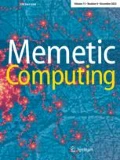Abstract
The visual background extractor (ViBe) has become one of the best motion object detection algorithms because of its good detection results and low memory requirements. However, the ViBe model cannot self-adjust the value range of the parameter that controls the number of samples chosen from the background template. In this paper, two models are proposed to help automatically change the parameter range in different environments. The blink energy model can detect dynamic backgrounds by increasing the range, while the object probability model can prevent corrosion of motion objects by decreasing the range. The experimental results show that our proposed method can both accurately recognize dynamic backgrounds and efficiently prevent object corrosion. In addition, our method shows better performance on benchmark datasets than several commonly used detection algorithms.




Similar content being viewed by others
References
Schaefer G, Krawczyk B, Celebi ME, Iyatomi H (2014) An ensemble classification approach for melanoma diagnosis. Memet Comput 6:233–240
Thammano A, Pravesjit S (2015) Recognition of archaic Lanna handwritten manuscripts using a hybrid bio-inspired algorithm. Memet Comput 7:3–17
Mei X (2006) Moving object detection algorithm based on space–time background difference. J Comput Aided Des Comput 18.7(2006):1044
Li H, Ma J, Gong M, Jiang Q, Jiao L (2015) Change detection in synthetic aperture radar images based on evolutionary multiobjective optimization with ensemble learning. Memet Comput 7:275–289
Alvarez L, Weickert J, Sánchez J (2000) Reliable estimation of dense optical flow fields with large displacements. Int J Comput Vis 39:41–56
Elhabian SY, El-Sayed KM, Ahmed SH (2008) Moving object detection in spatial domain using background removal techniques-state-of-art. Recent Pat Comput Sci 1:32–54
Stauffer C, Grimson WEL (2000) Learning patterns of activity using real-time tracking. IEEE Trans Pattern Anal Mach Intell 22:747–757
Stauffer C, Grimson WEL (1999) Adaptive background mixture models for real-time tracking. In: Computer Vision and Pattern Recognition, 1999. IEEE Computer Society Conference on, vol 2. IEEE
Wang Y, Loe K-F, Wu J-K (2006) A dynamic conditional random field model for foreground and shadow segmentation. IEEE Trans Pattern Anal Mach Intell 28:279–289
Lee D-S (2005) Effective Gaussian mixture learning for video background subtraction. IEEE Trans Pattern Anal Mach Intell 27:827–832
Wang Y, Liang Y, Zhang L, Pan Q (2012) Adaptive spatiotemporal background modelling. Comput Vis IET 6(5):451–458
Varadarajan S, Miller P, Zhou H (2015) Region-based mixture of Gaussians modelling for foreground detection in dynamic scenes. Pattern Recogn 48(11):3488–3503
Srivastava A, Lee AB, Simoncelli EP, Zhu S-C (2003) On advances in statistical modeling of natural images. J Math Imaging Vis 18:17–33
Elgammal A, Harwood D, Davis L (2000) Non-parametric model for background subtraction. In: Computer Vision—ECCV 2000. Springer, pp 751–767
Sheikh Y, Shah M (2005) Bayesian modeling of dynamic scenes for object detection. IEEE Trans Pattern Anal Mach Intell 27:1778–1792
Lee J, Park M (2012) An adaptive background subtraction method based on kernel density estimation. Sensors 12(9):12279–12300
Park JG, Lee C (2010) Bayesian rule-based complex background modeling and foreground detection. Opt Eng 49(2):027006–027006
Kim K, Chalidabhongse TH, Harwood D, Davis L (2005) Real-time foreground–background segmentation using codebook model. Real-time Imaging 11:172–185
Wu M, Peng X (2010) Spatio-temporal context for codebook-based dynamic background subtraction. AEU Int J Electron Commun 64:739–747
Lee J, Cheon M, Hyun CH, Eum H, Park M (2013) Adaptive background model for non-static background subtraction by estimation of the color change ratio. Electron Mater Lett 9(1):33–38
Oliver NM, Rosario B, Pentland AP (2000) A Bayesian computer vision system for modeling human interactions. IEEE Trans Pattern Anal Mach Intell 22:831–843
Saha S, Bandyopadhyay S (2011) On principle axis based line symmetry clustering techniques. Memetic Comput 3:129–144
Mahadevan V, Vasconcelos N (2010) Spatiotemporal saliency in dynamic scenes. IEEE Trans Pattern Anal Mach Intell 32:171–177
Han H, Zhu J, Liao S, Lei Z, Li SZ (2015) Moving object detection revisited: speed and robustness. IEEE Trans Circuits Syst Video Technol 25(6):910–921
Lu X (2014) A multiscale spatio-temporal background model for motion detection. In: Image Processing (ICIP), 2014 IEEE International Conference on, pp 3268–3271. IEEE
Barnich O, Van Droogenbroeck M (2011) ViBe: a universal background subtraction algorithm for video sequences. IEEE Trans Image Process 20:1709–1724
Van Droogenbroeck M, Paquot O (2012) Background subtraction: experiments and improvements for ViBe. In: Computer Vision and Pattern Recognition Workshops (CVPRW), 2012 IEEE Computer Society Conference on, pp 32–37. IEEE
Cheng L, Ding Y, Hao K, Hu Y (2012) An ensemble kernel classifier with immune clonal selection algorithm for automatic discriminant of primary open-angle glaucoma. Neurocomputing 83:1–11
Ding Y, Cheng L, Pedrycz W, Hao K (2015) Global nonlinear kernel prediction for large data set with a particle swarm-optimized interval support vector regression. IEEE Trans Neural Netw Learn Syst 26(10):2521–2534
Goyette N, Jodoin PM, Porikli F, Konrad J, Ishwar P (2014) A novel video dataset for change detection benchmarking. IEEE Trans Image Process 23(11):4663–4679
Acknowledgements
This work was supported in part by the Key Project of the National Natural Science Foundation of China (No. 61134009), the National Natural Science Foundation of China (Nos. 61473077, 61473078, 61503075, 61603090), Cooperative research funds of the National Natural Science Funds Overseas and Hong Kong and Macao scholars (No. 61428302), National Key Research and Development Plan from Ministry of Science and Technology (2016YFB0302700), Program for Changjiang Scholars from the Ministry of Education, International Collaborative Project of the Shanghai Committee of Science and Technology (No. 16510711100), Innovation Program of Shanghai Municipal Education Commission (No. 14ZZ067), Shanghai Science and Technology Promotion Project form Shanghai Municipal Agriculture Commission (No. 2016-1-5-12), Shanghai Pujiang Program (No. 15PJ1400100), and the Fundamental Research Funds for the Central Universities (No. 2232015D3-32).
Author information
Authors and Affiliations
Corresponding author
Rights and permissions
About this article
Cite this article
Yang, S., Hao, K., Ding, Y. et al. Improved visual background extractor with adaptive range change. Memetic Comp. 10, 53–61 (2018). https://doi.org/10.1007/s12293-017-0225-6
Received:
Accepted:
Published:
Issue Date:
DOI: https://doi.org/10.1007/s12293-017-0225-6



